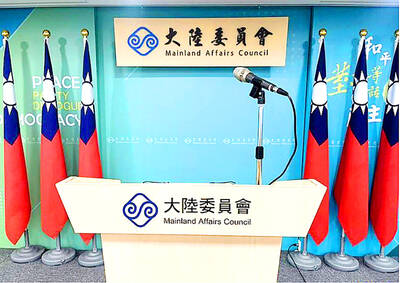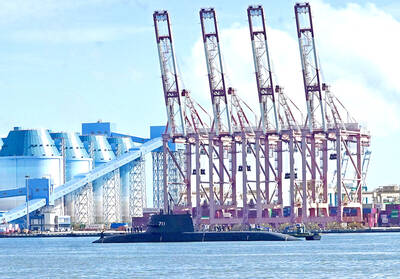The navy has been closely watching a former Soviet Union aircraft carrier that China bought from Ukraine in the name of a private company two years ago.
The ship had been moored in a Turkish port waiting for permission from the local government to pass through the Bosporus Straits, a military leader said recently.
It is estimated that the Varyag aircraft carrier is due to arrive at its announced destination -- Macao -- within one month of its passage through the Bosporus Straits of Turkey, said Navy Commander-in-Chief Admiral Li Chieh (李傑).
"We have been keeping a close eye on the ship. We have taken a lot of photos of it. We believe the main purpose for China buying the carrier is not to use it against Taiwan. But the possibility of other uses is still there," Li said.
Li made the remarks at a recent press dinner as part of his answer to inquiries about the navy's view on China's imminent acquisition of the best used aircraft carrier it has ever bought from a foreign country.
It is rumored that China will use the Varyag as the model for its first aircraft carrier. However, Li declined to confirm this.
China bought the Varyag from Ukraine in the name of a Macao-based travel agency. The agency has been widely reported by the Western press as a front organization for the Chinese military whose purpose is to develop a floating entertainment complex.
The Turkish government announced on Thursday that the green light for the Varyag to move through the Bosporus Straits could be given any time after Thursday. China has been waiting two years for this permission to be given.
The Turkish government had been reluctant to give permission for the Varyag to pass through the Bosporus straits because it thought it was dangerous for the giant engineless ship to move through the narrow waterways.
But due to intensive diplomatic efforts by high-level Chinese government officials over the past few months, Ankara eventually compromised with Beijing last week.
The Chinese government's active involvement in the negotiations with Turkey over the Varyag issue gives strength to speculation that the ship is to be used by China to develop its first aircraft carrier.
A defense official, who spoke on condition of anonymity, said it is estimated that China has the ability to build its first aircraft carrier in five years on the basis of designs it has learned from foreign countries.
"The question now is whether China is capable of properly maintaining the aircraft carrier after its becomes operational. It will surely force China to increase its defense spending," the official said.
"In addition, China does not have enough pilots to operate Russian-made Su-30 fighter-bombers, which it plans to deploy on its first aircraft carrier. Su-30 pilots have to be well-trained for landing on the deck of the carrier. China has a long way to go yet to get enough qualified pilots for the carrier-based Su-30s," he said.

CHIP WAR: The new restrictions are expected to cut off China’s access to Taiwan’s technologies, materials and equipment essential to building AI semiconductors Taiwan has blacklisted Huawei Technologies Co (華為) and Semiconductor Manufacturing International Corp (SMIC, 中芯), dealing another major blow to the two companies spearheading China’s efforts to develop cutting-edge artificial intelligence (AI) chip technologies. The Ministry of Economic Affairs’ International Trade Administration has included Huawei, SMIC and several of their subsidiaries in an update of its so-called strategic high-tech commodities entity list, the latest version on its Web site showed on Saturday. It did not publicly announce the change. Other entities on the list include organizations such as the Taliban and al-Qaeda, as well as companies in China, Iran and elsewhere. Local companies need

CRITICISM: It is generally accepted that the Straits Forum is a CCP ‘united front’ platform, and anyone attending should maintain Taiwan’s dignity, the council said The Mainland Affairs Council (MAC) yesterday said it deeply regrets that former president Ma Ying-jeou (馬英九) echoed the Chinese Communist Party’s (CCP) “one China” principle and “united front” tactics by telling the Straits Forum that Taiwanese yearn for both sides of the Taiwan Strait to move toward “peace” and “integration.” The 17th annual Straits Forum yesterday opened in Xiamen, China, and while the Chinese Nationalist Party’s (KMT) local government heads were absent for the first time in 17 years, Ma attended the forum as “former KMT chairperson” and met with Chinese People’s Political Consultative Conference Chairman Wang Huning (王滬寧). Wang

CROSS-STRAIT: The MAC said it barred the Chinese officials from attending an event, because they failed to provide guarantees that Taiwan would be treated with respect The Mainland Affairs Council (MAC) on Friday night defended its decision to bar Chinese officials and tourism representatives from attending a tourism event in Taipei next month, citing the unsafe conditions for Taiwanese in China. The Taipei International Summer Travel Expo, organized by the Taiwan Tourism Exchange Association, is to run from July 18 to 21. China’s Taiwan Affairs Office spokeswoman Zhu Fenglian (朱鳳蓮) on Friday said that representatives from China’s travel industry were excluded from the expo. The Democratic Progressive Party government is obstructing cross-strait tourism exchange in a vain attempt to ignore the mainstream support for peaceful development

DEFENSE: The US would assist Taiwan in developing a new command and control system, and it would be based on the US-made Link-22, a senior official said The Ministry of National Defense is to propose a special budget to replace the military’s currently fielded command and control system, bolster defensive resilience and acquire more attack drones, a senior defense official said yesterday. The budget would be presented to the legislature in August, the source said on condition of anonymity. Taiwan’s decade-old Syun An (迅安, “Swift Security”) command and control system is a derivative of Lockheed Martin’s Link-16 developed under Washington’s auspices, they said. The Syun An system is difficult to operate, increasingly obsolete and has unresolved problems related to integrating disparate tactical data across the three branches of the military,